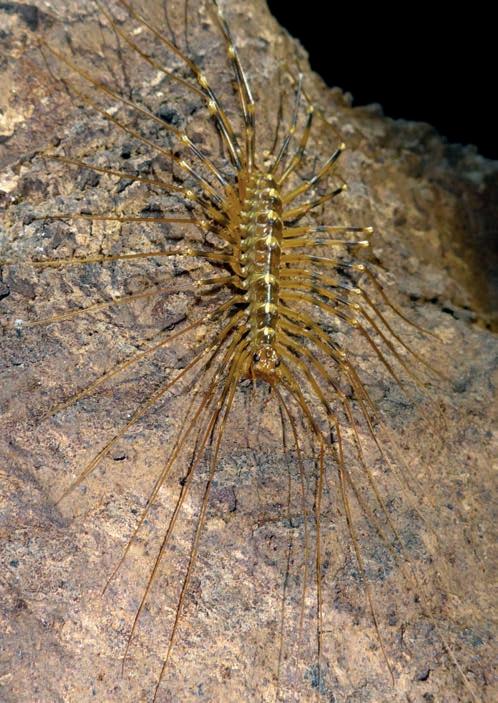
10 minute read
Life in the dark
LIFE IN THE DARK
Paolo Agnelli, Stefano Vanni
Advertisement
Zoologists are an unusual bunch, forever prepared to put themselves on the line by setting off to explore the most unusual of environments, in search of the natural mechanisms that govern those places and the creatures that populate them. When coming across bona fide explorers, who push themselves even harder, to the very limits of research, and who invite them to participate in a biospeleology expedition to one of the most beautiful caves in the world, the zoologists are not likely to demur. This is what happened to us when we accepted the invitation to share a new Philippine adventure with the speleologists of the La Venta Association, to study the extraordinary biological environment of the Puerto Princesa Underground River (PPUR) Cave on the island of Palawan. The limited knowledge of the fauna in this cave came from a pair of expeditions organised between 1990 and 2000. The urgent need to learn more about the fauna that populates the cave – recently recognised by UNESCO as a World Heritage Site – was due to the fact that the number of tourists visiting it has now reached the very substantial level of 1000 people a day! It was therefore important to evaluate the impact on the fauna of such an imposing anthropic presence before it was too late. Based on the results of the previous biological missions and on an examination of the photographs taken during the geological and speleological surveys, we knew that the place held many surprises in store. We had to wrestle with an enormous cave, playing host to an array of ecosystems that are very diverse because not only is there a large underground river, but also extensive, isolated fossil branches, as well as a second upstream entrance that puts the cave in contact with a beautiful rainforest. We could, then, envisage the presence of a plethora of different types of fauna. The task we set ourselves was to discover which species live in the cave, what ecological relationships bind them together, and which species are most under threat from the use of the environment by tourists. With a view to providing advice on appropriate tourist management, it was last but not least important for us to identify, out of
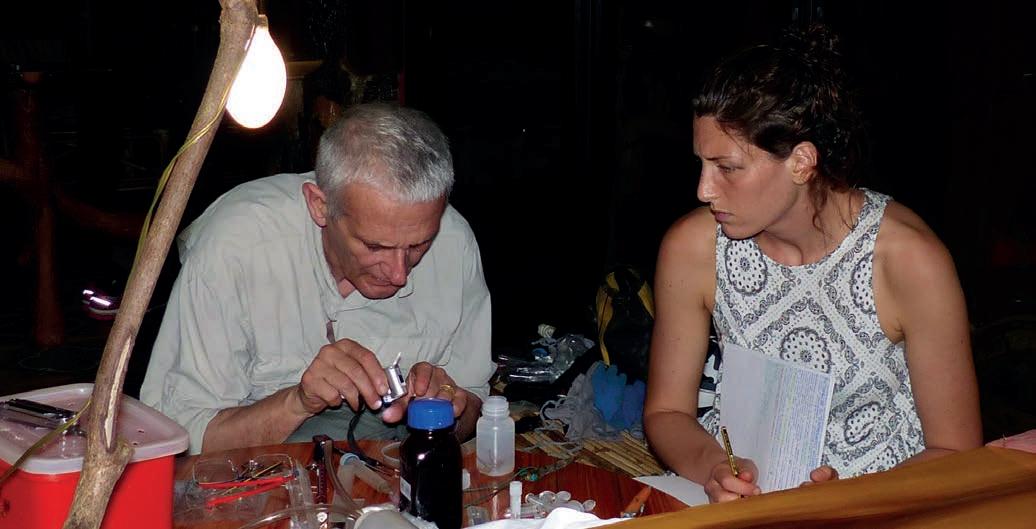
the most sensitive species, those that are easy to monitor, in order to use them as reliable bioindicators of tourist pressure. The greatest difficulty faced by zoologists in sites such as this is being able to access to the right sampling instrumentation at the right time. They have to be ready to whip out a light net to capture a bat and examine the species; a grabber to get hold of a poisonous snake; a long, sturdy pair of pincers to capture a surly tarantula; and small, soft pincers to collect delicate insects, scorpions, millipedes, scolopendrae, little spiders and crustaceans. Without forgetting a more robust net to immerse into the water to catch crabs, prawns and fish. You then need myriad different containers to allow you to conserve some of the samples you have caught so that you can examine them and then study them properly once you’re back at base camp. Our adventure began in November 2016 with a short mission, the purpose of which was principally to make contact with the personnel of the PPUR National Park, obtain the study permits and get a handle on the difficulties and problems that we may encounter when studying such an extensive, complex environment. On the basis of this initial survey we had identified thirty or so different zoological groups, many of which we had defined down to the species level, and the appetising presen
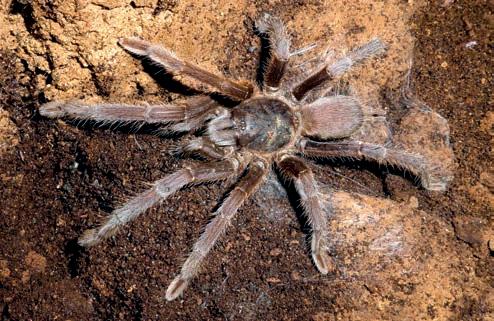
ce of at least nine species previously unknown to science! It was against this backdrop that we returned to Palawan in April 2017, better organised than before and with increased enthusiasm for what was to be a longer, more targeted mission. This time we had a richer team, and compared to the first expedition we had more time to study the fauna of the PPUR Cave and also that of the other caves that are located within the park, with the purpose of gleaning a better understanding of the biology of its karst complex. We spent entire days in the cave, assisted by the speleologists of La Venta and of the local caving groups Gaia Exploring Club and La Karst, followed by many evenings classifying and sorting out the material collected. It was laborious to say the least, but the results were not slow in coming and we realised immediately that the biodiversity of the PPUR Cave is quite extraordinary. Today, having examined the collected samples in our laboratories we can confirm that richness. The cave plays host to a full 17 species belonging to each of the classes of vertebrates: 4 fish, 1 amphibian, 3 reptiles, 2 birds, 7 mammals. For invertebrates, 11 different classes have been identified, amounting at the moment to a highly impressive 84 different taxonomic entities! This means that as the work of classification goes on, the number of different species will be at least 84. But that’s not all. Thus far, we have discovered at least 18 new species previously unknown to science! In other words, our hard work has really paid off! The study of animal groups that are the most difficult to determine requires the intervention of specialist zoologists, and often, for certain groups, these experts are very thin on the ground. To this end, another 31 specialists collaborate with us, from 15 different institutions in 10 different countries. Half of these specialists are associated with our Museum of Natural History at the University of Florence. Thanks to the work of this scientific community, it will be possible to classify every creature that lives in the cave and to describe the new species. It is a complex task that will necessarily take time to complete.
In order to work out the most appropriate conservation plans, it is necessary to get to know the animals that populate the cave and the strict ecological relationships that bind them together. We know that here, as in many
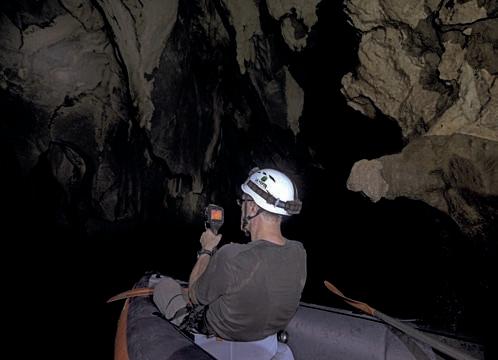
Shortly before sunset, the swiftlets re-enter the nest and the bats head out to hunt. A thermal camera trained on the river inside the cave makes it possible to estimate the numbers in question
other underground environments, the base of the food chain is constituted by the guano that swiftlets and bats release during their time in the cave. We calculated that the bats alone produce at least 30 kg of guano every day! This relevant quantity of organic substances provides nourishment for a large number of small detritivores, which in turn serve as food for other, larger animals. The bats and swiftlets themselves are preyed upon by large tarantulas, centipedes and snakes. In short, the presence of swallows and bats is the basis of life for a cave like this, and so we decided to count them and utilise these data in the future for impact analyses. For the count, we used a thermal camera, which allowed us to film the evening flow of the bats leaving the cave and the swiftlets coming in. The numbers are really high, and even taking account of the inevitable margin of error we can estimate that there are around 135,000 bats and 275,000 swiftlets! It’s amazing to think that this many creatures are prepared to take on the challenge, twice a day, of such a trip into the darkness! Bats have developed an ultrasound sonar that allows them to “see” in the dark with incredible precision. The true challenge, though, is that faced by the swiftlets. Given that they are diurnal birds, used to flying around in the sky in large open spaces, and that their sonar takes the form of simple twittering, what they do here is utterly breathtaking. They make their way deep into the cave following the river, for up to 5 kilometres, to reach the specific point where they make their nests, perhaps concealed in some narrow cranny. It takes immense effort, which must have had an important selective premium over the course of their evolution. Indeed, the ability to live in a dark environment that is inaccessible to other animals reduces the predatory pressure on adults, eggs and nestlings, and it also eliminates the competition with other birds for the vital spaces needed for nesting and resting. From our repeated nocturnal observations with the thermal camera, a behaviour emerged that implied additional advantages and that would merit further investigation. After their evening return to the cave, many birds continue to fly around the large galleries and chambers, for many hours, even if the nest has been reached. There can only be one reasonable and plausible explanation: the swiftlets continue to hunt insects in flight, taking advantage both of the abundant presence of their prey in the cave and above all of the possibility to use their sonar. In fact, sonar functions only when there is the opportunity for it to bounce off a nearby obstacle, otherwi
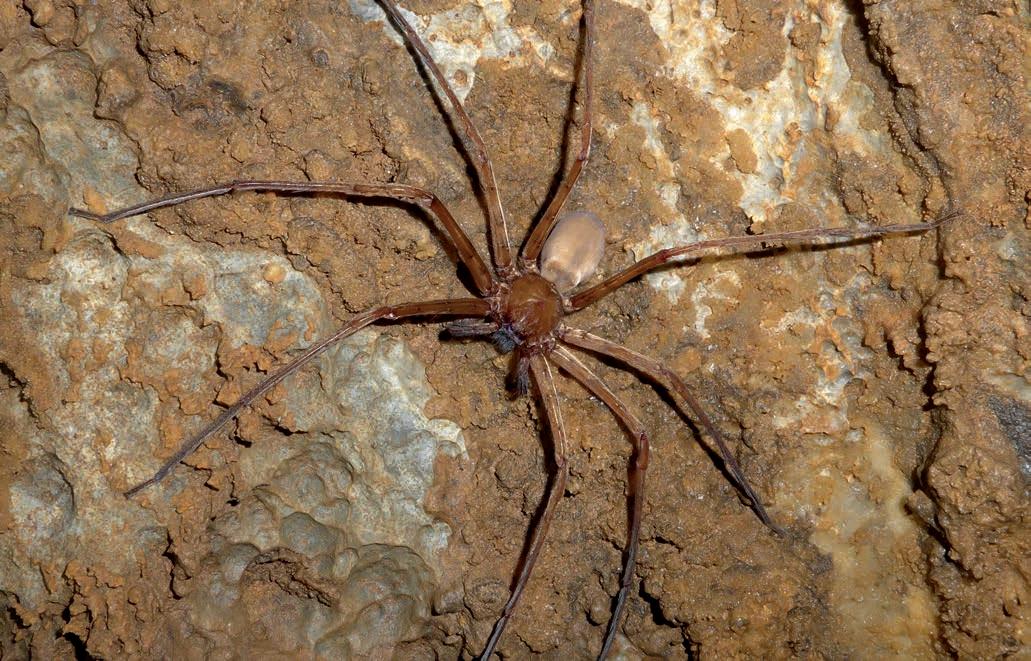
se the sound emitted fades away before it can rebound. Externally, once darkness falls the swiftlets have to interrupt their “unconcealed” hunting, but in the relatively reduced spaces of a cave they can continue to search for food by orienting themselves with their sonar. This supplementary source of food constitutes a real advantage, especially in the challenging reproductive period! Our work will continue for many months yet in order to
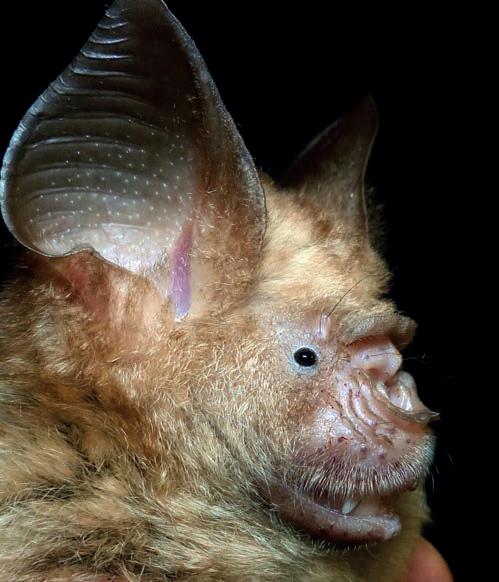
The diadem leaf-nosed bat, Hipposideros diadema, is the largest of the seven species of chiropters that populate the cave. They group into large colonies with thousands of members
reach the best classification of the rarest animals, about which science knows very little, but an important result has already been achieved. To this end, we left the management of the Park of the Puerto Princesa Underground River a set of precise instructions on the management of the tourist flows within the caves that we studied. For the PPUR Cave, which is the most important, any effort to conserve the extraordinary animal biodiversity there must take account of the following points: • The cave must be closed to visitors from two hours before sunset until two hours after sunrise. • Visitors must always remain on the bancas (boats used for the visits) without ever setting foot on the ground. • Excursions along the river should extend no further than the God’s Highway, in line with the fossil remains of Dugongo. Any further spatial extension of the anthropic pressure would force the chiropters to waste too much energy to reach the calmer shelters. • Light and noise generated by the visiting tourists are the main sources of disturbance for the animals. It is important to reduce these levels substantially. • The floodlight should be manoeuvred, discreetly, only by the guide piloting the boat; visitors should not use any other light sources. • The guide should ensure that the visitors behave responsibly and respectfully, not raising their voices. Information should be provided to visitors exclusively
Swimming along the river, the Palawan ratsnake, Coelognthus philippinus, can even reach deep inside the cave to prey on bats and swiftlets
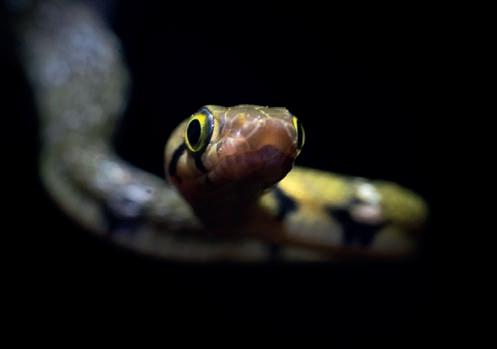
through an audioguide and headsets. • During the months of spring, particular care should be taken not to disturb the reproductive colonies of chiropters (mothers with their young) that are concentrated in the first section after the entrance. • Every month, it is important to monitor the number of bats in the first section of the cave, in the morning, simply by counting them by eye, so that seasonal variations can be highlighted along with any changes in the populations in the “tourist” section. This monitoring will constitute a useful bioindicator of anthropic pressure. In this way it will be possible to manage the biodiversity of this beautiful cave and to allow visitors to get the most out of the experience of being there, without impacting excessively on the extraordinary, fragile ecosystems to which it plays host.
